Have you ever wondered why some classrooms feel magical while others feel plain? Are you struggling to find the right classroom decoration ideas that are both affordable and inspiring? Worried your kindergarten room lacks personality or functionality for kids?
Here’s the powerful truth: a well-decorated classroom is the foundation for a thriving learning environment. Not only does it spark creativity and engagement in young minds, but it also creates a space where children feel safe, inspired, and ready to learn. And the best part? Transforming your space doesn’t require a hefty budget—just a few smart, creative ideas.
Stick with me, because in this post, I’m going to share 15 of the best classroom decoration ideas that I’ve seen work wonders in kindergartens around the world.
1. Themed Learning Walls
Themed walls are one of the best ways to turn your classroom into a visually stimulating and interactive learning environment. Themed walls can serve as both a decorative element and an educational tool, transforming the classroom into a place where children can learn about the world in a fun and exciting way.
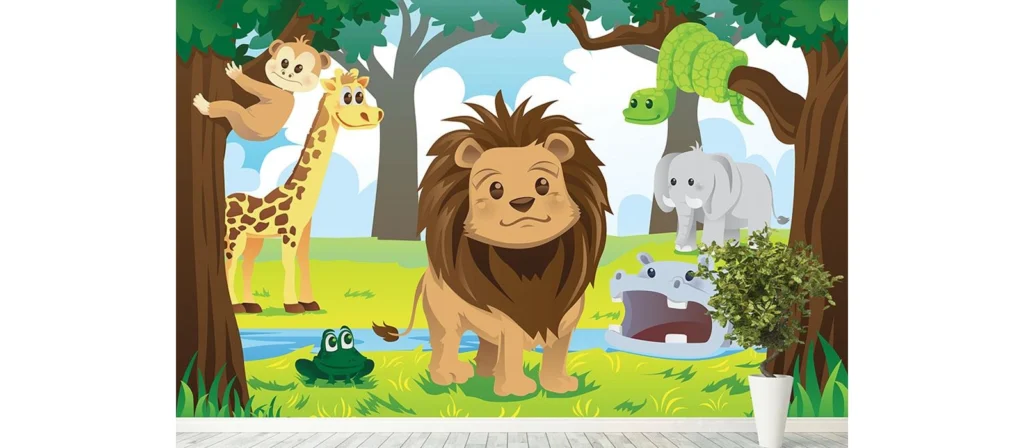
- Animal Kingdom Wall: A wall dedicated to animals is a fantastic way to teach children about nature and wildlife. You can include posters of various animals, their habitats, and interesting facts. Add textured elements like fabric or felt for the children to touch, such as animal fur or feathers, to make the wall interactive.
- Execution Tip: Divide the wall into sections based on continents or animal species—each section can showcase animals from different parts of the world, providing a geography lesson along with the animal facts. You could also incorporate a “Guess the Animal” game where children match animal silhouettes to their names.
- Visual Design: Use large, colorful images of animals, combined with a few smaller, interactive pieces that children can manipulate, like moving animal stickers or wheels that reveal more fun facts when turned. This makes the learning process dynamic and visually engaging.
- Space Exploration Wall: A space-themed wall can inspire a sense of wonder in young learners as they explore the solar system, planets, and astronauts. You can decorate with glow-in-the-dark stars and planets that come to life in the dark.
- Execution Tip: Add a timeline of space exploration, from the first moon landing to modern-day space missions. This encourages children to learn about history and advancements in science.
- Interactive Features: Include a “Rocket Launch Pad” where children can create their own rockets from paper and launch them against the wall, learning about science concepts like force and motion while decorating.
2. Interactive Bulletin Boards
Bulletin boards are more than just space fillers—they are an essential part of classroom decoration ideas that can inspire learning and engagement. By transforming bulletin boards into interactive displays, you can make them work as both functional and decorative elements in your classroom.

- Shape and Color Matching Board: Use a large bulletin board with cut-out shapes in different colors and sizes. Add matching cards with corresponding colors and shapes that children can attach to the board.
- Execution Tip: Create a game out of it, where children have to match the shapes and colors based on a story or theme you introduce. For example, “The Hungry Caterpillar” could be used to show how different colors and shapes come together in nature.
- Visual Design: Keep the background simple to ensure that the focus remains on the colorful shapes. You could even make it a monthly theme, changing the shapes and colors each month to correspond with the children’s learning journey.
- “What’s the Weather Today?” Bulletin Board: A weather-themed board is an excellent way to introduce children to basic meteorology while adding to the classroom’s aesthetic. Use Velcro pieces to allow children to change weather icons daily, such as a sun, cloud, or rain.
- Execution Tip: Teach children about weather-related vocabulary like sunny, cloudy, rainy, windy, and snowy. Incorporate these terms into lessons and activities throughout the day.
- Visual Design: Create a simple, clean layout with space to add new weather icons daily. Use different textures, such as cotton for clouds or glitter for snow, to make the board visually dynamic.
3. Personalized Art Wall
Personalizing your classroom with children’s artwork creates a sense of ownership and pride. It also provides a fun and colorful way to decorate the classroom while celebrating each child’s creativity. Displaying their work sends the message that their contributions matter and that they have a voice in the classroom.
- “Our Gallery” Art Display: Dedicate an entire wall to displaying student artwork. Use simple frames or inexpensive clipboards to hang their creations. This makes it easy to rotate new art pieces in and out, keeping the display fresh and dynamic.
- Execution Tip: Create a rotating art exhibit where children can take turns “curating” the wall by choosing what artwork to display. This promotes a sense of community and gives children a chance to express their preferences.
- Visual Design: Keep the frame design simple and uniform to allow the art to stand out. Use vibrant colors for the frames or backing paper to complement the artwork without overwhelming it.
- Craft Project Area: Designate a space for children to showcase their crafts, such as handprints, clay models, or paper animals. This area could also have shelves to store ongoing projects.
- Execution Tip: Add small label cards to each child’s artwork, noting the title, date, and any fun details the child shares about their creation. This gives the art a personal touch and helps children engage with their work.
4. Reading Nook
A reading nook is one of the most cherished areas in any kindergarten classroom. It’s a space for children to escape into stories, enhancing their literacy skills while providing a calm, cozy corner to relax in. Transforming a corner into a dedicated reading space is one of the most effective classroom decoration ideas.

- Cozy Reading Corner: Add soft cushions, bean bags, or small chairs to create a comfortable area for reading. Line the walls with shelves filled with books, and add some fun, child-friendly posters that encourage reading.
- Execution Tip: Organize the books by theme—such as animals, space, fairy tales, or emotions—so children can easily pick books based on their interests.
- Visual Design: Use soft, inviting colors for the furniture and walls. Consider creating a “storybook wall” with characters from the books on display, creating a visual connection to the stories they will find inside.
- Interactive Bookshelves: Set up a bookshelf with rotating displays of new or seasonal books. Place one or two books on an easel so that they stand out and can catch the children’s attention.
- Execution Tip: Introduce a weekly “book of the week” to keep the space fresh and exciting. This could be a story that ties into classroom themes or activities, creating a unified learning experience.
5. Nature Corner
Introducing nature into the classroom helps children connect with the environment and understand the world around them. A nature corner can incorporate plants, natural materials, and eco-friendly decor to bring a calming and organic element to your classroom.
- Plant Corner: Adding plants to your classroom is an easy way to incorporate nature. Choose low-maintenance plants like succulents, spider plants, or peace lilies, which thrive in classroom environments and require minimal care.
- Execution Tip: Set up a plant care routine with the children, allowing them to water and take care of the plants as part of their learning process.
- Visual Design: Use decorative pots or planters that align with the classroom’s color scheme, and make sure plants are displayed at child-friendly heights so they can interact with them.
- Nature-Inspired Artwork: Hang artwork featuring natural scenes, such as forests, oceans, or mountains. You could also incorporate real elements like leaves, flowers, or feathers into the decor.
- Execution Tip: For hands-on interaction, provide children with materials to create their own nature-inspired art, like pressing leaves or creating flower collages.
6. Functional Storage Solutions
Organizing your classroom while keeping it visually appealing is a challenge. However, it’s one of the most critical aspects of classroom decoration ideas that can significantly impact the classroom’s atmosphere and functionality.
- Color-Coded Bins: Use colorful storage bins for different learning materials, such as blocks, crayons, and puzzles. Label each bin with both words and pictures, so young children can easily identify where everything belongs.
- Execution Tip: Incorporate a color system that matches the classroom’s theme. For example, use blue bins for reading materials, red for art supplies, and green for toys.
- Visual Design: Choose bins that stack easily and fit under tables or shelves, keeping everything neat while adding a splash of color.
- Shelving Units with a Twist: Instead of traditional shelving, opt for floating shelves or cubby units that serve as both functional storage and part of the decor.
- Execution Tip: Use open shelves to store books and toys, and add a few decorative items, like small plants or educational toys, that match the classroom’s overall design.
7. Inspirational Quote Wall
Adding an inspirational quote wall is one of the most impactful classroom decoration ideas that can help motivate students and create a positive atmosphere for learning. A wall full of uplifting messages can significantly influence children’s mindset and promote good behavior throughout the year.
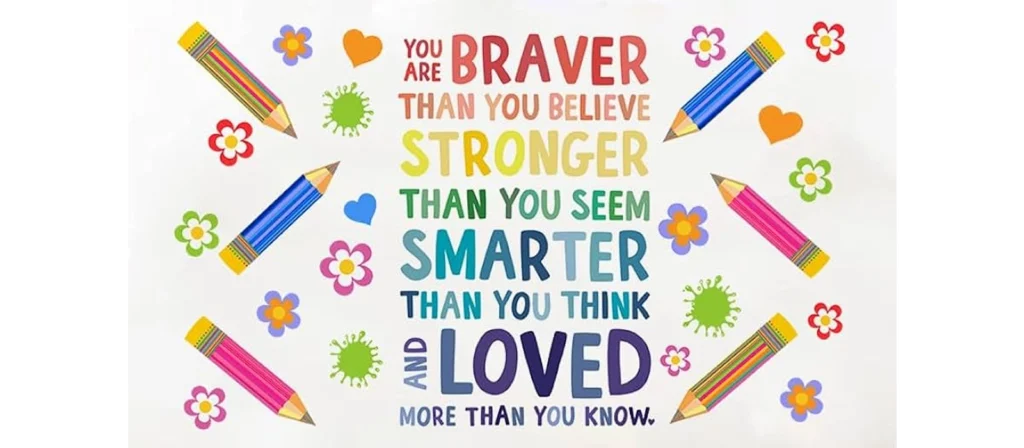
- Motivational Messages: Incorporating positive quotes on a dedicated wall not only beautifies the classroom but also reinforces values like perseverance, kindness, and the love of learning. For instance, you could feature quotes like “You are braver than you believe” or “Every day is a new opportunity to grow.”
- Execution Tip: Changing the quotes on the wall regularly is a great way to maintain engagement. You can even ask the children to contribute their favorite motivational quotes. This way, they feel more involved in the process.
- Visual Design: Use Classroom Decoration Ideas like bright, colorful fonts to make the quotes stand out. Combine these with playful elements like hand-drawn designs or framed pictures to create an inspirational visual display.
- Character-Building Quotes: Additionally, display quotes that highlight values like teamwork and empathy. These types of Classroom Decoration Ideas contribute to building a supportive classroom culture where children are encouraged to help each other.
- Execution Tip: Rotate the quotes to tie in with the classroom’s monthly theme. For instance, if you focus on kindness in a particular month, all the quotes could center around being kind to others.
- Visual Design: Make sure the quotes are large enough for all students to see and reflect on throughout the day.
8. DIY Wall Decals
Wall decals are an easy, effective, and inexpensive classroom decoration idea that can transform a plain wall into an interactive learning tool. They provide a fun, customizable way to enhance the educational atmosphere of the room.
- Alphabet Decals: Decorate the classroom walls with large, vibrant alphabet decals to help students reinforce their letter recognition skills. Pair these letters with images of animals or objects that correspond to each letter to make learning fun and engaging.
- Execution Tip: Consider using Classroom Decoration Ideas that feature interactive letters or numbers. Children can practice matching the letters with corresponding objects, promoting active learning.
- Visual Design: Use a bright color palette for the decals, ensuring they are large and clear enough for children to engage with easily. The fun, cartoonish designs of the letters will make the space feel playful and educational.
- Growth Chart Wall Decal: A growth chart decal on the wall offers both a functional and fun classroom decoration idea. It provides a visual record of each child’s growth throughout the year and engages them in the learning process.
- Execution Tip: Incorporate the growth chart into the classroom theme. For example, if you have a nature theme, use a tree trunk with branches that grow taller as the children’s heights increase.
- Visual Design: Ensure the decal is placed at a child’s eye level so they can easily track their progress and feel excited about their growth.
9. Classroom Door Decorations
Your classroom door is one of the most prominent spaces for classroom decoration ideas. It sets the tone for the classroom and gives both students and visitors their first impression of the learning environment.
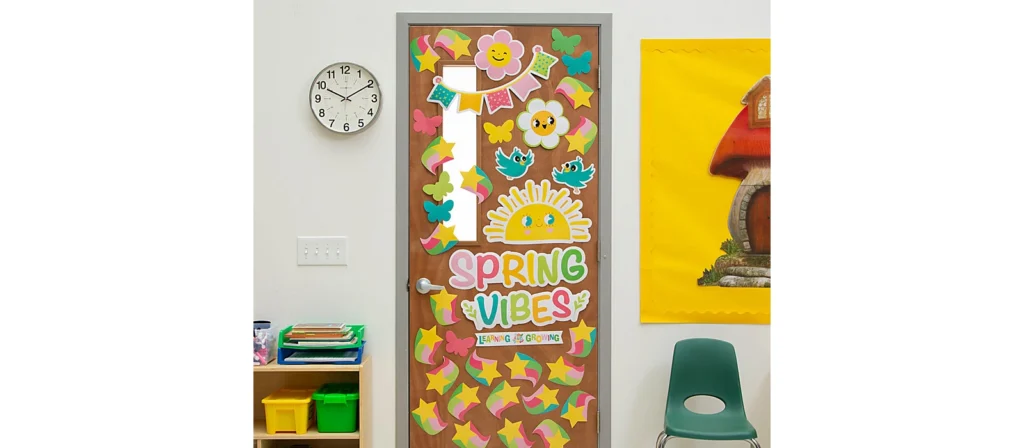
- Fun Door Mural: Decorate your classroom door with a fun mural that complements the classroom theme. For example, if you have an ocean theme, paint or stick fish, waves, and coral on the door. You could also design it based on popular stories or seasons to create a warm and welcoming atmosphere.
- Execution Tip: Change the door mural with the seasons or learning topics. If you’re learning about space, decorate the door with planets and rockets to keep it relevant to the students’ current lessons.
- Visual Design: Use bold, bright colors that will catch the children’s attention. Consider adding textures, like paper clouds or felt animals, to give the door an interactive element.
- Interactive Door Décor: Incorporating interactive elements into your classroom door decoration ideas makes the space more engaging. For example, have a “Name of the Day” section where each child gets to write their name or something they’re excited about when they enter the classroom.
- Execution Tip: You can create an activity on the door like a daily question or a countdown to the next holiday or event. This encourages children to interact with the door and feel more connected to their classroom environment.
- Visual Design: Keep the design playful and colorful, ensuring the interactive features are clearly visible. Use elements like chalkboard paint or magnetic strips to make the door even more engaging.
10. Creative Table Settings
Classroom tables don’t have to be boring—they can serve as functional parts of your classroom decoration ideas that encourage creativity, organization, and engagement.
- Personalized Place Settings: Set up each table with personalized place settings that reflect the students’ personalities or the classroom theme. This could include custom placemats or tablecloths with each child’s name or favorite animals.
- Execution Tip: Let children contribute to their place settings by helping to decorate their name tags or place mats. This can build excitement and involvement from the start.
- Visual Design: Match the table settings with your overall classroom theme, using colors and designs that enhance the environment. For instance, a forest theme could feature green placemats with animal cutouts.
- Decorative Table Centerpieces: Add small centerpieces to each table that tie into the classroom’s theme or enhance its educational atmosphere. For example, use small plants, books, or educational toys.
- Execution Tip: Rotate these centerpieces as different subjects are taught, so that the decor supports current lessons or themes.
- Visual Design: Choose centerpieces that are functional as well as decorative. Items like small plants or books are great because they can also encourage learning while adding a visual flair to the tables.
11. Wall Mirrors for Exploration
Wall mirrors are a creative classroom decoration idea that can enhance both the learning and visual appeal of your classroom. Not only do mirrors make the space feel larger, but they also provide a tool for self-reflection and exploration.
- Decorative Mirrors: Use mirrors with fun frames in various shapes like stars, animals, or geometric designs to add visual interest.
- Execution Tip: Place the mirrors at eye level for young learners so they can use them to explore different facial expressions, practice speech sounds, or learn about symmetry.
- Visual Design: The frames should complement the classroom’s overall aesthetic—choose bright, cheerful colors for a playful vibe or neutral tones for a more minimalist style.
- Mirror Art: Incorporate mirrors as part of your art wall, where children can see their creations reflected. This adds an interactive dimension to their work and encourages them to engage more deeply with their art.
- Execution Tip: Attach small mirrors to specific areas of the art wall, allowing children to use them as part of the creative process. This could be used for activities like tracing, coloring, or exploring reflections.
- Visual Design: Use mirrors sparingly and ensure that they enhance the existing artwork without overwhelming the space. Ensure the mirrors are safe, child-friendly, and securely attached.
12. Thematic Learning Mats
Thematic learning mats are another classroom decoration idea that can be both decorative and educational. They are a great way to reinforce concepts like shapes, numbers, and letters while also adding color and texture to the classroom.
- Learning Mats with Numbers and Letters: Create colorful mats with numbers, letters, and animals to help children practice basic skills. These mats can also serve as places for circle time or group activities.
- Execution Tip: Organize mats in learning centers based on subject—one for math, one for reading, and one for art. Children can sit on these mats while engaging in activities related to the mats’ themes.
- Visual Design: Keep the mats bright and colorful, using large, easy-to-read letters and numbers. This makes it easy for children to learn while adding vibrancy to the space.
- Nature-Themed Mats: Incorporate mats with natural patterns like leaves, trees, or animals. These mats can tie into your nature corner and enhance the classroom’s connection to the environment.
- Execution Tip: Use these mats during activities like nature walks or science lessons. You can also add small figurines or educational tools to the mats, encouraging hands-on learning.
- Visual Design: Ensure the designs are simple and bold, so they’re easy for children to engage with while remaining in line with the classroom’s theme.
13. Sensory Play Area
Sensory play areas are essential in any classroom decoration ideas for kindergartens. These areas not only add a playful and colorful aspect to the classroom but also provide children with opportunities to engage their senses through hands-on experiences. Sensory play encourages exploration, creativity, and development of fine motor skills.
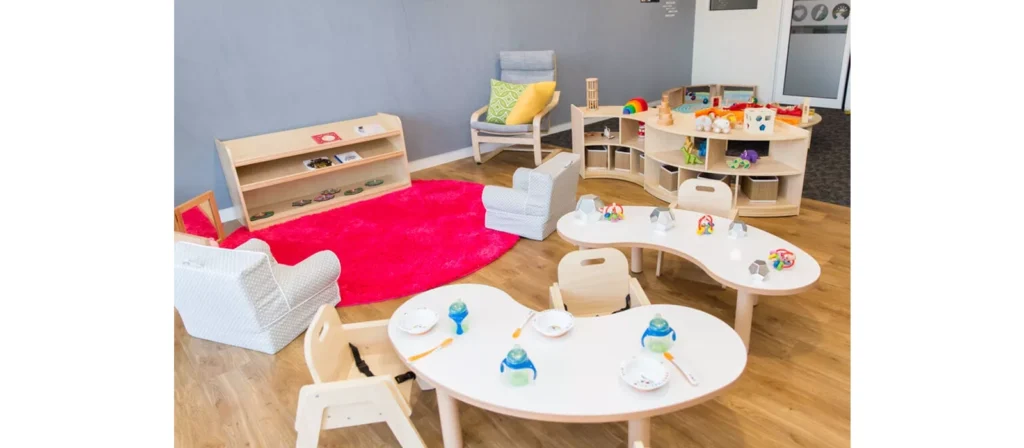
- Sensory Bins: Setting up sensory bins with various materials like sand, rice, water beads, or fabric swatches can create a tactile learning experience. Label each bin with images or words that describe the textures inside, helping children learn new vocabulary while exploring.
- Execution Tip: Rotate sensory bins regularly to keep the children engaged and introduce them to different materials. You can even tie the bins to specific lessons or classroom themes—such as creating a “dinosaur dig” bin for learning about prehistoric animals or a “nature exploration” bin with leaves and rocks.
- Visual Design: Ensure the sensory bins are clearly labeled with large, easy-to-read signs. You can use bright, colorful labels that match the classroom’s theme, which adds visual appeal while keeping the bins organized.
- Interactive Sensory Walls: Add an interactive sensory wall to your classroom decoration ideas. These walls can feature various textures, such as soft fabric, smooth plastic, or rough sandpaper, that children can touch and explore. This tactile experience promotes sensory development and allows children to engage more deeply with their surroundings.
- Execution Tip: You can create a “feely wall” by attaching different fabrics, materials, and objects that represent different textures. For example, a fluffy cloud of cotton, a bumpy textured surface for “rocks,” and a smooth surface for “water.” This sensory wall can be an ongoing activity that the children explore daily.
- Visual Design: Use bright, bold colors for the textures and ensure the textures are easy for children to interact with. The sensory wall should be at a height that is accessible to all students.
14. Encouraging Teamwork with Group Projects
Group projects are a fantastic way to encourage collaboration and teamwork, and they also make for excellent classroom decoration ideas. By engaging children in creative group tasks, you can foster a sense of responsibility, promote social skills, and create a visually appealing classroom at the same time.
- Group Art Projects: One of the most rewarding classroom decoration ideas for teamwork is creating large-scale group art projects. Whether it’s a mural, mosaic, or collaborative painting, these projects allow children to work together while decorating the classroom.
- Execution Tip: Organize the group projects by assigning each child a specific area of the artwork. For example, if creating a mural, one group can focus on the background, while another group works on characters or objects within the mural. This method not only helps children work as a team but also gives them a sense of ownership over the final product.
- Visual Design: Ensure that the group projects reflect the classroom’s theme and are displayed prominently in the room. For example, a “seasons” mural could showcase the four seasons, with children contributing their own seasonal drawings.
- Interactive Team Boards: Another excellent way to encourage teamwork in the classroom is by setting up interactive team boards. These can be used to track group progress on projects, celebrate achievements, and encourage positive competition.
- Execution Tip: Set up a team board that tracks different class projects or classroom goals. For example, children can earn points for group achievements such as completing a craft or learning a new song. This encourages friendly competition while emphasizing teamwork.
- Visual Design: Use a fun, color-coded system to keep track of each team’s progress. You can display the board in a high-traffic area of the classroom so that children see their progress regularly, which motivates them to continue contributing to their group.
15. Playful Ceiling Decorations
Ceiling decorations are often overlooked but can be one of the most impactful classroom decoration ideas. A well-decorated ceiling can transform the entire space, creating an atmosphere that sparks imagination and enhances the overall learning experience.
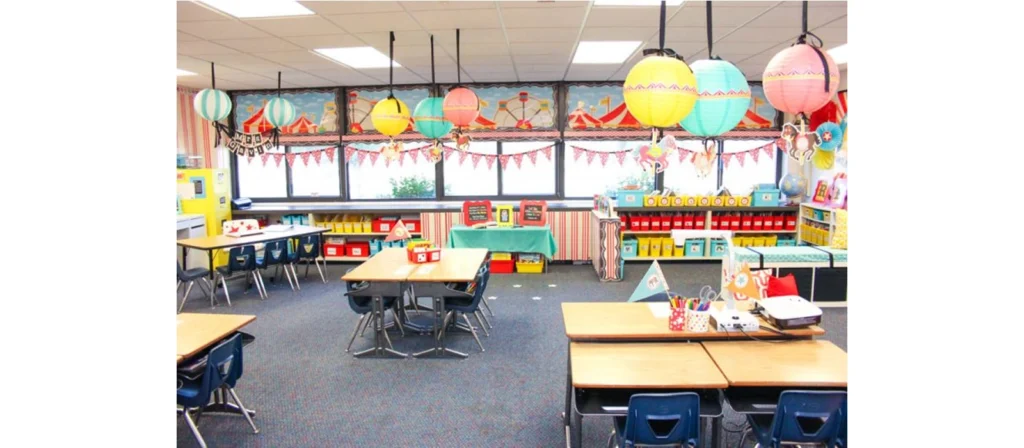
- Hanging Paper Lanterns: Adding hanging paper lanterns to the classroom ceiling can bring a playful, whimsical element to the space. These lanterns can be colorful and themed to fit the classroom’s decor. For example, you could use lanterns shaped like flowers for a spring theme or colorful balloons for a birthday or celebration theme.
- Execution Tip: Suspend the lanterns at different heights from the ceiling to create depth and visual interest. Ensure they are securely fastened so they don’t pose a hazard to the children.
- Visual Design: Keep the design consistent with the classroom’s theme—bright and cheerful colors for a fun vibe or soft pastels for a calming atmosphere. You can also incorporate LED string lights around the lanterns to add a magical touch when the lights are dimmed.
- Starry Night Ceiling: Transform the ceiling into a “starry night” sky with glow-in-the-dark stars and moon decals. This classroom decoration idea can be both visually striking and calming, creating a sense of wonder and awe.
- Execution Tip: Create constellations using the glow-in-the-dark decals to teach children about astronomy and the stars. As children lie on the floor or look up, they can explore the constellations and learn their names.
- Visual Design: For a magical effect, make sure the stars are evenly distributed across the ceiling and use different sizes for added dimension. The moon can be placed in a prominent spot, glowing brightly to captivate children’s attention.
Conclusion
Incorporating creative Classroom Decoration Ideas is an essential part of creating an engaging, inspiring, and functional learning environment for young children. Whether it’s transforming the classroom for special occasions, celebrating the changing seasons, or designing spaces that foster creativity and learning, the right decorations can make a significant impact.
From festive holiday themes like Christmas and Halloween to seasonal changes such as fall and spring, each Classroom Decoration Idea offers a unique opportunity to enrich students’ experiences. Decorations not only enhance the aesthetic appeal of the classroom but also encourage interaction, learning, and a sense of ownership over their space.



